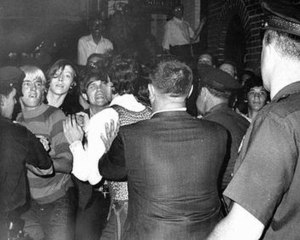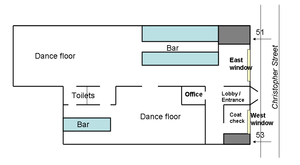Riots
Police raid
At 1:20 in the morning on Saturday, June 28, 1969, four
plainclothes
policemen in dark suits, two patrol officers in uniform, and Detective
Charles
Smythe and Deputy Inspector Seymour Pine arrived at the Stonewall Inn's
double
doors and announced "Police! We're taking the place!" Two undercover
policewomen and two undercover
policemen had entered the bar earlier that evening to gather visual
evidence, as
the Public Morals Squad waited outside for the signal. Once inside, they
called
for backup from the Sixth Precinct using the bar's pay telephone. The
music was
turned off and the main lights were turned on. Approximately
200 people were in
the bar that night. Patrons who had never experienced a police raid
were
confused, but a few who realized what was happening began to run for
doors and
windows in the bathrooms. Police barred the doors, and confusion spread.
Michael
Fader remembered, "Things happened so fast you kind of got caught not
knowing.
All of a sudden there were police there and we were told to all get in
lines and
to have our identification ready to be led out of the bar."

The raid did not go as planned. Standard procedure was to line up the
patrons, check their identification, and have female police officers
take
customers dressed as women to the bathroom to verify their sex, upon
which any
men dressed as women would be arrested. Those dressed as women that
night
refused to go with the officers. Men in line began to refuse to produce
their
identification. The police decided to take everyone present to the
police
station, and separated the transvestites in a room in the back of the
bar. Maria
Ritter, who was known as Steve to her family, recalled, "My biggest fear
was
that I would get arrested. My second biggest fear was that my picture
would be
in a newspaper or on a television report in my mother's dress!" Both
patrons and police recalled that a sense of discomfort spread very
quickly,
spurred by police who began to "bully" some of the lesbians by "feeling
some of
them up inappropriately" while frisking them.
When did you ever see a fag fight back?... Now, times were
a-changin'.
Tuesday night was the last night for bullshit.... Predominantly, the
theme
(w)as, "this shit has got to stop!"
The police were to transport the bar's alcohol in patrol wagons.
Twenty-eight
cases of beer and nineteen bottles of hard liquor were seized, but the
patrol
wagons had not yet arrived, so patrons were required to wait in line for
about
15 minutes. Those
who were not arrested were released from the front door, but they did
not leave
quickly as usual. Instead, they stopped outside and a crowd began to
grow and
watch. Within minutes, between 100 and 150 people had congregated
outside, some
after they were released from inside the Stonewall, and some after
noticing the
police cars and the crowd. Although the police forcefully pushed or
kicked some
patrons out of the bar, some customers released by the police performed
for the
crowd by posing and saluting the police in an exaggerated fashion. The
crowd's
applause encouraged them further: "Wrists were limp, hair was primped,
and
reactions to the applause were classic."

When the first patrol wagon arrived, Inspector Pine recalled that the
crowd—most of whom were homosexual—had grown to at least ten times the
number of
people who were arrested, and they all became very quiet.
Confusion over radio communication delayed the arrival of a second
wagon. The
police began escorting Mafia members into the first wagon, to the cheers
of the
bystanders. Next, regular employees were loaded into the wagon. A
bystander
shouted, "Gay power!", someone began singing "We Shall
Overcome", and the crowd reacted
with amusement and general good humor mixed with "growing and intensive
hostility".[58] An officer shoved
a transvestite, who responded by hitting him on the head with her purse
as the
crowd began to boo. Author Edmund White, who
had been passing by, recalled,
"Everyone's restless, angry, and high-spirited. No one has a slogan, no
one even
has an attitude, but something's brewing. Pennies, then beer
bottles, were thrown at the wagon as a rumor spread through the crowd
that
patrons still inside the bar were being beaten.

A scuffle broke out when a woman in handcuffs was escorted from the
door of
the bar to the waiting police wagon several times. She escaped
repeatedly and
fought with four of the police, swearing and shouting, for about ten
minutes.
Described as "a typical New York butch" and "a dyke—stone butch", she
had been
hit on the head by an officer with a billy club for, as one witness claimed, complaining
that her handcuffs were too tight. Bystanders
recalled that the woman, whose identity remains unknown, sparked the crowd to fight when she looked at
bystanders and shouted, "Why don't you guys do something?" After an
officer
picked her up and heaved her into the back of the wagon
the crowd became a mob and went "berserk": "It was at that moment that
the scene
became explosive".
"The last
straw"
The police tried to restrain some of the crowd, and knocked a few
people
down, which incited bystanders even more. Some of those handcuffed in
the wagon
escaped when police left them unattended (deliberately, according to
some
witnesses). As the crowd tried
to overturn the police wagon, two police cars and the wagon—with a few
slashed
tires—left immediately, with Inspector Pine urging them to return as
soon as
possible. The commotion attracted more people who learned what was
happening.
Someone in the crowd declared that the bar had been raided because "they
didn't
pay off the cops", to which someone else yelled "Let's pay them off!
Coins
sailed through the air towards the police as the crowd shouted "Pigs!"
and
"Faggot cops!" Beer cans were thrown and the police lashed out,
dispersing some
of the crowd, who found a construction site nearby with stacks of
bricks. The
police, outnumbered by between 500 and 600 people, grabbed several
people,
including folk singer Dave
Van Ronk—who had been attracted to the revolt from a bar two doors
away from
the Stonewall. Though Van Ronk was not gay, he had experienced police
violence
when he participated in antiwar demonstrations: "As far as I was
concerned,
anybody who'd stand against the cops was all right with me, and that's
why I
stayed in.... Every time you turned around the cops were pulling some
outrage or
another. Ten
police officers—including two policewomen—barricaded themselves, Van
Ronk,
Howard Smith (a writer for The Village Voice), and several
handcuffed
detainees inside the Stonewall Inn for their own safety.
Multiple accounts of the riot assert that there was no pre-existing
organization or apparent cause for the demonstration; what ensued was
spontaneous. Michael Fader
explained,
We all had a collective feeling like we'd had enough of this kind of
shit. It
wasn't anything tangible anybody said to anyone else, it was just kind
of like
everything over the years had come to a head on that one particular
night in the
one particular place, and it was not an organized demonstration....
Everyone in
the crowd felt that we were never going to go back. It was like the last
straw.
It was time to reclaim something that had always been taken from us....
All
kinds of people, all different reasons, but mostly it was total outrage,
anger,
sorrow, everything combined, and everything just kind of ran its course.
It was
the police who were doing most of the destruction. We were really trying
to get
back in and break free. And we felt that we had freedom at last, or
freedom to
at least show that we demanded freedom. We weren't going to be walking
meekly in
the night and letting them shove us around—it's like standing your
ground for
the first time and in a really strong way, and that's what caught the
police by
surprise. There was something in the air, freedom a long time overdue,
and we're
going to fight for it. It took different forms, but the bottom line was,
we
weren't going to go away. And we didn't.

This photograph appeared in the front
page of The New York
Daily News on Sunday,
June 29, 1969, showing the "street kids" who were the first to fight
with the
police.
The only photograph taken during the first night of the riots shows
the
homeless youth that slept in nearby Christopher Park, scuffling with
police. The Mattachine
Society newsletter a month later offered its explanation of why the
riots
occurred: "It catered largely to a group of people who are not welcome
in, or
cannot afford, other places of homosexual social gathering.... The
Stonewall
became home to these kids. When it was raided, they fought for it. That,
and the
fact that they had nothing to lose other than the most tolerant and
broadminded
gay place in town, explains why.
Garbage cans, garbage, bottles, rocks, and bricks were hurled at the
building, breaking the windows. Witnesses attest that "flame queens",
hustlers,
and gay "street kids"—the most outcast people in the gay community—were
responsible for the first volley of projectiles, as well as the
uprooting of a
parking meter used
as a
battering ram on
the
doors of the Stonewall Inn. Sylvia Rivera, who
was in
full drag and had been in the Stonewall during the raid, remembered:
"You've
been treating us like shit all these years? Uh-uh. Now it's our turn!...
It was
one of the greatest moments in my life. The mob lit
garbage on fire and stuffed it through the broken windows as the police
grabbed
a fire hose. Because it had no water pressure, the hose was ineffective
in
dispersing the crowd, and seemed only to encourage them. When
demonstrators broke through the windows—which had
been covered by plywood by the bar
owners to deter the police from raiding the bar—the police inside
unholstered
their pistols. The doors flew open and officers pointed their weapons at
the
angry crowd, threatening to shoot. The Village Voicelighter fluid into
the bar; as it was lit and the
police took aim, sirens were heard and fire trucks arrived. The
onslaught had
lasted 45 minutes.
TO BE CONTINUED TOMORROW




